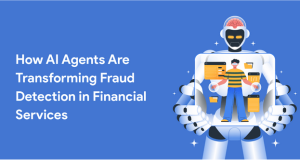
ManekTech
AI increases operational possibilities in restructuring customers’ interactions, as well as helps businesses automate their processes. The greatest impact of AI comes from Virtual Assistants that augment communication while simultaneously bringing efficiency and customized interaction to the end user.
The global custom software development market size was estimated at USD 35.42 billion in 2023and it is projected to grow at a CAGR of 22.5% from 2024 to 2030. It is only logical to suggest that perfect alignment of the AI-driven virtual assistants to the business goals needed of a company would need a custom software development company.
In this article, we will discuss the need for custom software development services in the AI virtual assistant along with necessary factors and challenges, proactive approaches, and business strategies for optimum utilization of the required system.
Why Custom Software Development for AI Virtual Assistants?
The business motivation for a change in paradigms of virtual assistants means that users require unique AI assistants with problem-solving tailored to the business environment. Custom development offers:
- Personalization: It allows different business needs such as workflows, integration, and automation sequences to be customized.
- Scalability: Since custom-built assistants are specifically developed for the unique needs of the business, cases show that they are capable of adapting to address increasing loads.
- Data Security & Compliance: Ensuring compliance with industry standards such as GDPR, HIPAA, and SOC 2.
- Views & Functions Personalization: To make the usage of an application, involving more components requires extensive personalization.
- Competitive Advantage: Businesses gain unique features unavailable in generic AI solutions.
Core Components of an AI-driven Virtual Assistant
Developing a custom AI-driven virtual assistant requires several key components, each contributing to its intelligence and efficiency.
1. Natural Language Processing (NLP)
Through NLP, virtual assistants can decode human speech and create responses that emulate human communication. OpenAI’s GPT alongside Google’s BERT advance NLP models allow assistants to process both linguistic content and message meaning with emotional interpretations.
2. Machine Learning Algorithms
Through ML algorithms the assistant develops abilities to learn from user motions which results in enhanced accuracy and performance levels. The combination of reinforcement learning systems with deep learning methods enables central improvement of the response systems through time.
3. Speech Recognition & Text-to-Speech (TTS)
Users can interact with voice-enabled virtual assistants through their speech recognition capabilities while TTS systems ensure natural responses are delivered to the user. Specific jargon into the modeling process leads to better accuracy in the system.
4. Backend Processing & APIs
The architectural foundation brings together databases with AI models and business logic elements to function properly. Third-party applications including CRM, ERP and customer support systems are connected to each other through APIs to enable smooth data exchange.
5. Context Awareness & Memory
The ultimate mark of intelligence in an assistant system comes from its ability to retain past dialogue patterns which produce context-driven answers. Both problem resolution quality and meaningful dialogue quality improve through the power of memory retention.
6. User Interface & Experience (UI/UX)
A user-friendly interface design between chat and voice interaction helps users achieve better performance. Floatable visual designs combined with virtual avatar assistance and intelligent interface systems help users stay involved throughout their interaction.
Challenges in Developing AI-driven Virtual Assistants
Despite their advantages, custom AI virtual assistants pose several development challenges. Addressing these when you hire software engineers ensures optimal performance and reliability.
1. Understanding Complex Queries
Virtual communication requires users to communicate using various formats including slang together with abbreviations and ambiguous expressions. The extent of training needed for NLP models becomes essential for achieving accurate processing of different types of input data.
2. Data Quality & Training
The training process of AI systems needs extensive databases. Data curation becomes essential due to poor-quality or biased datasets because they produce invalid and discriminatory responses.
3. Real-time Response Optimization
Fast responses in AI applications need robust processing capabilities together with caching systems and architecture with quick response times. The implementation of optimization procedures results in both fast and appropriate response times.
4. Multi-language & Localization Support
A business that aims to expand internationally must develop its services to work across multiple languages. AI assistants become more sophisticated when they are designed to understand various languages and cultural sensitivities, but this development path becomes intricate.
5. Integrations with Legacy Systems
The integration process for business infrastructure becomes problematic when legacy systems are run. APIs for custom use and middleware solutions serve as tools for integrating dissimilar system frameworks.
6. Security Risks & Ethical Concerns
AI virtual assistants pose security challenges because they process confidential information which causes privacy risks together with potential discrimination and ethical flaws related to artificial intelligence usage. Developers need to build security protocols with built-in fairness standards for their algorithms.
Best Practices for Custom Software development of AI virtual assistants
To build an effective and scalable AI-driven virtual assistant, businesses should follow best practices in software development.
1. Define clear objectives & use cases
Before development, outline specific use cases, such as customer support automation, appointment scheduling, lead generation, or internal process optimization.
2. Choose the right AI models
Select AI frameworks based on the required functionalities. Options include:
- GPT-4 for conversational AI
- BERT for contextual understanding
- Whisper AI for speech-to-text conversion
- Custom ML models for domain-specific needs
3. Build a scalable architecture
Adopt a microservice architecture, allowing modular and scalable development. Cloud-based solutions like AWS, Google Cloud, and Azure provide flexibility and performance.
4. Prioritize data security & compliance
Implement robust security measures, including:
- End-to-end encryption
- Role-based access controls
- Secure API authentication
- GDPR and HIPAA compliance mechanisms
5. Continuously train & optimize AI models
AI models require ongoing refinement by AI development company. Use reinforcement learning, feedback loops, and periodic retraining with updated datasets to improve accuracy and performance.
Conclusion
The deployment of artificial intelligence in virtual assistant technology has radically changed how software development agency approach customer relations while optimizing their operational procedures. The complete activation of these systems requires customized software development solutions.
We at ManekTech specialize in creating AI-powered virtual assistants that meet the specific requirements of your business operations. Our knowledge of machine learning and AI together with NLP technology and secure integration expertise creates virtual assistants that are smart and scalable alongside being secure and efficient.
ManekTech serves as your reliable partner by providing complete AI solution offerings ranging from customer support chatbots to enterprise automation frameworks. Get in touch with us today and revolutionize your business with a custom AI-driven virtual assistant!







